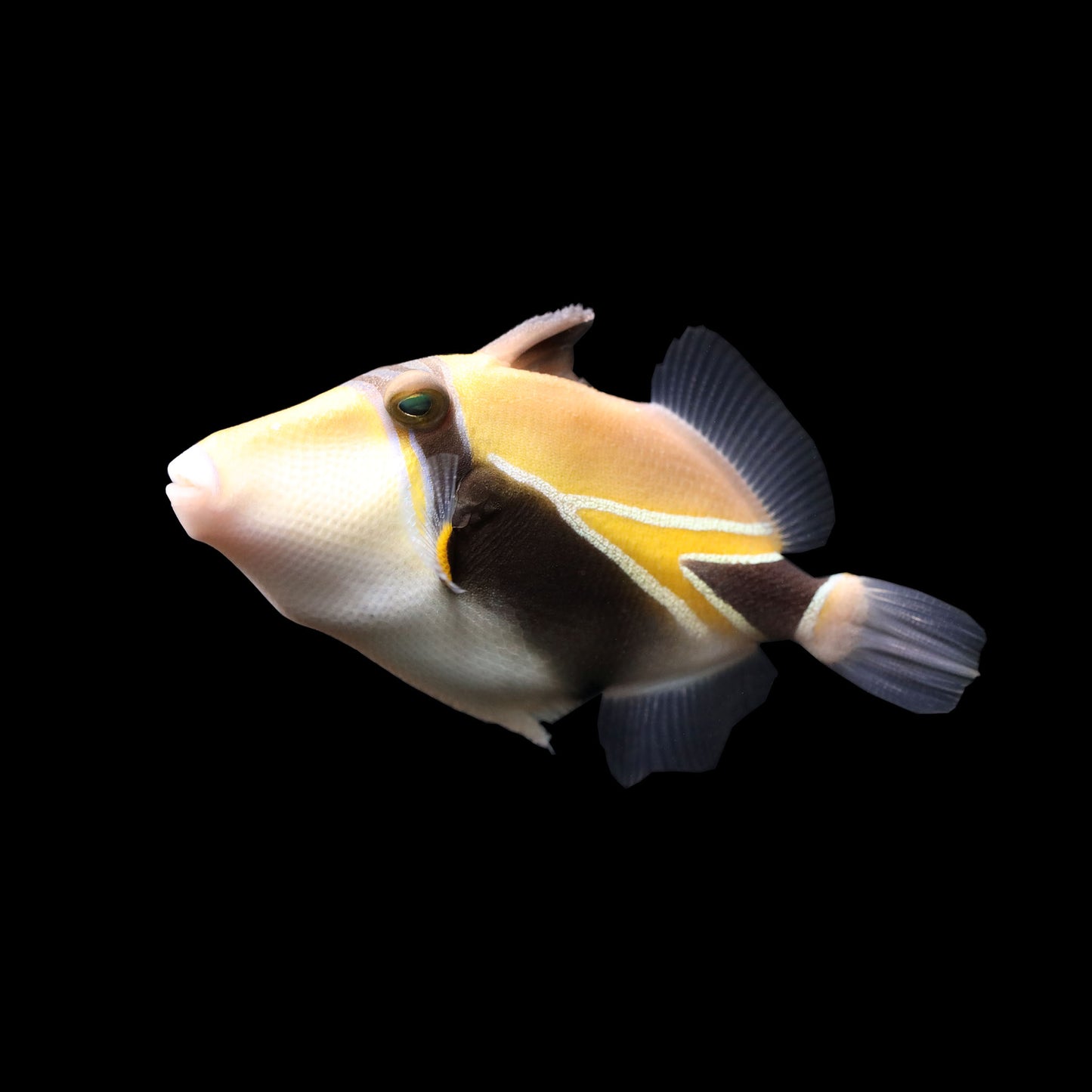AQUARIUM ARTS
Rectangle Triggerfish (Rhinecanthus rectangulus)
Rectangle Triggerfish (Rhinecanthus rectangulus)
Couldn't load pickup availability
Rectangle Triggerfish (Rhinecanthus rectangulus)
Discover the Bold and Striking Rectangle Triggerfish
The Rectangle Triggerfish is a bold and hardy species that brings both beauty and personality to any marine aquarium. Known for its striking coloration and distinctively marked body, this triggerfish is an excellent choice for experienced aquarists looking for a lively and robust addition to their fish-only setups. With its unique look and strong personality, the Rectangle Triggerfish is sure to be the centerpiece of your aquarium.
Appearance: The Rectangle Triggerfish features a stunning array of colors and patterns. Its body is predominantly olive or grayish-green, with a distinctive black rectangle-shaped marking running across its sides. Bright blue and yellow lines frame its eyes and mouth, adding to its captivating appearance. The wedge-shaped tail is another defining characteristic of this species, making it stand out in any marine tank. The contrasting patterns and vibrant accents make the Rectangle Triggerfish a visually striking addition to any aquarium.
Behavior: Rectangle Triggerfish are active, confident swimmers with bold personalities. They are known for being territorial, especially as they mature, and are best suited for tanks with other robust fish species. Their curious and sometimes aggressive nature means they will explore every inch of the tank, interacting with décor and tankmates. They are also known for rearranging substrate and rocks, making them fun and entertaining to observe. However, their territorial behavior requires careful planning when selecting tankmates.
Diet: The Rectangle Triggerfish is a carnivore and thrives on a varied diet of meaty foods. They enjoy high-quality marine pellets, frozen foods such as krill, shrimp, squid, and chopped clams, and occasionally live foods like crabs and mollusks. Regular feedings are important to keep them healthy and satisfied. Their strong jaws are designed to crush hard-shelled prey, so it's beneficial to offer foods like shell-on shrimp or clams to help maintain their dental health.
Tank Requirements: Due to their size and active nature, Rectangle Triggerfish require a minimum tank size of 180 gallons. The tank should be well-structured with plenty of live rock to provide hiding spots and territory, along with ample open swimming space. Since they are known to rearrange the tank décor, secure rocks and decorations are essential. Excellent filtration and regular water changes are important for maintaining the high water quality needed to keep this species healthy.
Tankmates: Rectangle Triggerfish can be semi-aggressive and territorial, especially in smaller tanks. Suitable tankmates include larger, robust fish such as tangs, groupers, and other aggressive or semi-aggressive species. Avoid housing them with small or timid fish, as they may be bullied or even seen as prey. It's also best to avoid keeping them with invertebrates, as they will likely nip at or consume them. Providing plenty of space and hiding spots will help reduce territorial disputes.
Reef Aquarium Compatibility: The Rectangle Triggerfish is not considered reef-safe, as it has a tendency to nip at corals and consume invertebrates such as shrimp, crabs, and snails. They are best kept in fish-only or fish-only with live rock (FOWLR) setups, where their bold personality can shine without the risk of harming delicate reef organisms.
Max Size: Rectangle Triggerfish can grow up to 10 inches (25 cm) in length. Due to their size and territorial behavior, they require a large and well-maintained aquarium to thrive.
Origin: The Rectangle Triggerfish is native to the Indo-Pacific region, where it can be found in coral reefs and lagoons, often patrolling the rocky crevices for food.
Interesting Facts:
-
Rectangle Triggerfish are known for their distinctive wedge-shaped tails and bold markings, making them one of the most recognizable triggerfish species.
-
Their strong jaws allow them to crush hard-shelled prey, which is why providing proper food is essential for their dental health.
-
These fish are incredibly hardy and long-lived when properly cared for, making them a rewarding species for experienced aquarists.
Disclaimer: Aquarium Arts cannot guarantee compatibility with your current fish or the fish you buy and cannot be held liable for fish lost due to aggression.
Share


